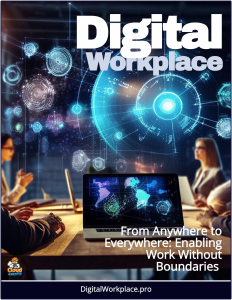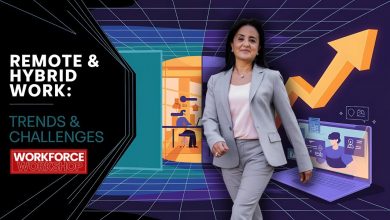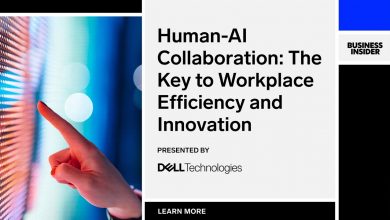‘Workforce 4.0’ – Digital Labor and AI Agents
AI agents can significantly enhance team collaboration and process productivity within enterprises by automating routine tasks, providing real-time insights, and fostering seamless communication.
 The integration of AI into the digital workplace is fundamentally reshaping how organizations operate, fostering a dynamic and efficient environment that enhances productivity, collaboration, and innovation.
The integration of AI into the digital workplace is fundamentally reshaping how organizations operate, fostering a dynamic and efficient environment that enhances productivity, collaboration, and innovation.
AI-powered tools are transforming routine tasks and enabling employees to focus on high-value, creative work.
By automating repetitive processes, such as data entry, scheduling, and customer inquiry responses, AI frees up time for strategic thinking and problem-solving. For instance, virtual assistants and chatbots streamline communication, while intelligent algorithms analyze vast datasets to provide actionable insights.
This shift not only boosts efficiency but also empowers employees to engage in work that drives meaningful outcomes, fostering a culture of innovation and adaptability.
Agentic Ai Enterprise Collaboration
Welcome to Workforce 4.0 — a bold new frontier where digital labor and AI agents emerge as tireless allies, amplifying human potential and redefining the heartbeat of enterprise.
As the boundaries between the physical and virtual dissolve, these intelligent systems promise to unlock unprecedented collaboration, ignite productivity, and propel us toward a future where every idea finds its wings. This is more than a revolution; it’s an invitation to dream bigger, work smarter, and build a legacy of limitless possibility.
Beyond task automation, AI enhances collaboration by breaking down geographical and temporal barriers. Tools like AI-driven project management platforms and real-time translation services enable seamless teamwork across global offices.
These technologies ensure that teams can collaborate effectively, regardless of location or language, by providing instant translations, summarizing discussions, and prioritizing tasks based on predictive analytics.
For example, AI can anticipate project bottlenecks by analyzing historical data and suggest adjustments to keep teams on track. To maximize these benefits, organizations should invest in user-friendly platforms and provide training to ensure employees can leverage these tools effectively, fostering a collaborative environment that embraces diverse perspectives.
Personalization is another key advantage of AI in the digital workplace. By leveraging machine learning, AI tailors workflows, content, and recommendations to individual employee preferences and roles. This personalization enhances engagement and productivity by delivering relevant resources at the right time.
For instance, AI-driven learning platforms can recommend training modules based on an employee’s career goals and performance gaps, creating a customized growth path.
To implement this effectively, organizations should prioritize data privacy and transparency, ensuring employees understand how their data is used to build trust and encourage adoption. Regular feedback loops can further refine these personalized experiences, aligning them with evolving employee needs.
Cyber AI
AI also plays a critical role in strengthening cybersecurity and compliance, safeguarding sensitive data in an increasingly digital world. AI-powered systems monitor networks in real-time, detecting anomalies and potential threats faster than traditional methods.
Additionally, AI ensures compliance with regulations like GDPR by automating data audits and flagging non-compliant practices. Organizations should complement these tools with robust cybersecurity training and clear policies to create a secure digital workplace. By proactively addressing risks, businesses can maintain trust and operational integrity while leveraging AI to stay ahead of emerging threats.
Despite its transformative potential, integrating AI into the workplace requires a strategic approach to overcome challenges like employee resistance and ethical concerns.
Transparent communication about AI’s benefits, such as its ability to reduce mundane tasks and enhance job satisfaction, can alleviate fears of job displacement. Upskilling programs are essential to prepare employees for an AI-augmented future, equipping them with skills to work alongside intelligent systems.
For example, training in data analysis or AI tool management can empower employees to thrive in new roles. Additionally, organizations must establish ethical AI frameworks, ensuring fairness, accountability, and inclusivity in AI-driven decisions. Engaging employees in the AI adoption process through pilot programs and feedback sessions can further build trust and drive successful implementation.
Implementation
To fully realize AI’s potential, organizations should adopt best practices that align technology with human-centric goals. This includes selecting AI tools that integrate seamlessly with existing systems, prioritizing scalability and interoperability. Regular audits of AI performance can identify areas for improvement, ensuring alignment with business objectives.
Collaboration between IT, HR, and leadership teams is crucial to create a cohesive AI strategy that addresses both technical and cultural needs. By fostering a culture of continuous learning and adaptability, organizations can harness AI to create a future-ready digital workforce that drives innovation and sustainable growth.



